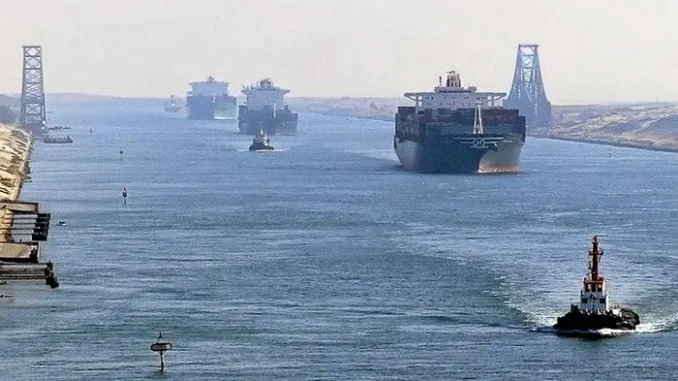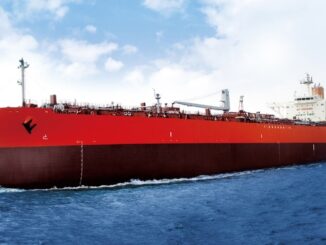
In a stark reminder of the vulnerabilities in global energy supply chains, the Suez Canal was temporarily blocked early today after a sanctioned oil tanker, part of Russia’s shadowy “dark fleet,” ran aground in the vital waterway. The incident, involving a Hong Kong-owned vessel laden with Russian crude, halted northbound traffic for several hours, disrupting one of the world’s busiest shipping routes.
The tanker was one of four blacklisted ships in a convoy transporting Russian oil to Asia, highlighting the growing risks posed by these unregulated vessels.
Egyptian authorities quickly refloated the ship, but the event has reignited debates over the dark fleet’s role in evading international sanctions and the potential for broader disruptions in global oil flows.
The Dark Fleet: A Shadowy Network Evading Sanctions
The dark fleet, also known as the shadow fleet, refers to a clandestine armada of aging tankers used to transport oil from sanctioned nations while bypassing Western restrictions. These vessels often operate with opaque ownership, minimal insurance, and frequent flag-hopping to obscure their origins. Primarily, they enable the export of crude from countries like Russia, Iran, and Venezuela, filling the coffers of regimes under heavy economic pressure.
Key issues surrounding the dark fleet include severe safety and environmental risks. Many ships are old, poorly maintained, and lack proper classification from reputable maritime bodies, increasing the likelihood of accidents like groundings, spills, or collisions. For instance, these tankers often disable their Automatic Identification Systems (AIS) to avoid detection, a practice known as “going dark,” which heightens navigational hazards.
Additionally, the fleet has been linked to human trafficking and exploitation of seafarers, who are lured into dangerous jobs on these unregulated vessels.
From an enforcement perspective, the dark fleet undermines global sanctions by allowing sanctioned oil to reach markets undetected, potentially reshaping trade patterns and inflating energy prices through hidden supply chains.
Scale and Scope: How Many Ships, and Who’s Involved?
Estimates of the dark fleet’s size vary, but recent analyses peg it at around 600 to 1,600 vessels actively involved in transporting sanctioned oil. For context, out of nearly 7,500 oil tankers globally, over 1,600 have carried sanctioned cargoes at some point, with an average of about 558 tankers operating in this shadowy capacity between 2017 and 2023.
In 2024 alone, 735 tankers picked up at least one Russian cargo.
A subset of 193 tankers has been reported to shuttle products between multiple sanctioned countries, demonstrating the fleet’s adaptability.
The primary countries using the dark fleet for shipping oil are Russia, Iran, and Venezuela, which rely on these vessels to export crude despite Western embargoes. Russia, in particular, has expanded its use of the fleet following the 2022 invasion of Ukraine and subsequent G7 price caps on its oil exports.
On the buying side, major importers include China and India, which have become key destinations for discounted Russian crude. Other buyers, such as Turkey and certain Southeast Asian nations, also participate, often refining or re-exporting the oil to blend it into global markets.
|
Aspect
|
Details
|
|---|---|
|
Estimated Fleet Size
|
600–1,600 vessels (active in sanctioned oil transport)
|
|
Primary Exporters
|
Russia, Iran, Venezuela
|
|
Key Buyers
|
China, India, Turkey
|
|
Notable Risks
|
Safety hazards, environmental spills, sanction evasion, human exploitation
|
Global Choke Points: Vulnerable Arteries of Oil Trade
- Strait of Hormuz: The world’s busiest, funneling 17-21 mb/d (about 20% of global oil). Connects the Persian Gulf to the Arabian Sea; disruptions here could spike prices dramatically.
- Strait of Malacca: Handles 16-24 mb/d, linking the Indian and Pacific Oceans. Vital for Asian imports; blockages force lengthy detours around Indonesia.
- Suez Canal: 5-6 mb/d, shortcut between Europe and Asia. Alternatives involve rounding Africa’s Cape of Good Hope, adding weeks and costs to voyages.
- Bab el-Mandeb Strait: 4-6 mb/d, entrance to the Red Sea from the Indian Ocean. Recent Houthi attacks have already rerouted some traffic.
- Panama Canal: 2-3 mb/d, connecting Atlantic and Pacific. Droughts and capacity limits have caused delays.
- Turkish Straits (Bosporus and Dardanelles): 2-3 mb/d, Black Sea to Mediterranean route for Russian and Kazakh oil.
- Danish Straits: 3 mb/d, Baltic Sea exports primarily from Russia.
These points collectively account for over half of global seaborne oil trade, making them prime targets for geopolitical tensions or accidents.
For Russia, which relies on these shortcuts for efficient exports to Asia, such measures could deny billions in revenue, as seen with recent U.S. and EU actions targeting oil majors like Rosneft and Lukoil.
If choke points were systematically blocked, global supply chains could tighten, leading to sustained increases in oil prices—potentially by $5-10 per barrel or more, depending on the scale—ultimately raising gasoline and heating costs for households worldwide.
As the Suez incident resolves, it serves as a wake-up call: the dark fleet’s expansion not only threatens maritime safety but also the stability of energy markets. Policymakers must weigh stronger enforcement against the risk of broader economic fallout in an already volatile world.






Be the first to comment